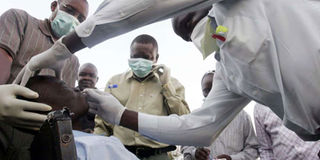No avian and swine flu in Kenya, ministry says after outbreak fears

Health officials examine a patient after a swine flu scare in Kisumu on October 3, 2009. PHOTO | FILE | NATION MEDIA GROUP
What you need to know:
- The ministry encouraged the public to seek medical attention in case of cold-like symptoms with an abrupt or sudden onset of a sore throat, fever, headache, muscle-aches and chest discomfort or congestion and a cough.
- Data from influenza surveillance in Kenya over the last 10 years shows that the viruses circulate throughout the year, with peaks from February to April and June to November.
- In March 2018, a child died while more than 60 people were infected with the H1N1 prototype 9 influenza virus following an outbreak in Nanyuki.
The Ministry of Health has declared Kenya free of the avian and swine flu following a scare of an outbreak of the deadly diseases over the weekend.
“The ministry would like to confirm to the Public that there is no case of avian flu (type A/H1N1) or swine flu (type A/H3N2v) in Kenya," stated a statement released on Monday morning.
"The four cases reported in Nairobi County are of severe acute respiratory illness (SARI) caused by the influenza virus (type A/H3N2).One patient regrettably succumbed to the illness on July 19."
The cases were reported at MP Shah Hospital.
The other three patients are responding positively to treatment, with one being treated as an outpatient.
COLD SYMPTOMS
The ministry, however, encouraged the public to seek medical attention in case of cold-like symptoms with an abrupt or sudden onset of a sore throat, fever, headache, muscle-aches and chest discomfort or congestion and a cough.
The statement clarified that when one has a common cold, a fever is rare, the onset of symptoms quite gradual and aches or chills rare.
People with the above symptoms were advised to limit contact with others to keep from spreading disease.
They were also asked to cover the nose and mouth with a tissue when coughing or sneezing and dispose of it in a dustbin, as well as wash their hands often with soap and water.
“Clean and disinfect surfaces and objects that may be contaminated with germs like the flu, drink plenty of warm fluids and keep warm,” said the statement.
SURVEILLANCE
Data from influenza surveillance in Kenya over the last 10 years shows the viruses circulate throughout the year, with peaks from February to April and June to November.
In March 2018, a child died while more than 60 people were infected with the H1N1 prototype 9 influenza virus following an outbreak in Nanyuki.
The ministry has heightened emergency response to the influenza virus and has dispatched a rapid response team to undertake field investigations.
Samples from suspected cases that were analysed at national public health laboratories confirmed the influenza type A flu.
County health management teams and the Division of Disease Surveillance and Response are undertaking contact tracing for suspected cases among contacts of the affected while the ministry is monitoring stock levels of medicines including
Tamiflu.





